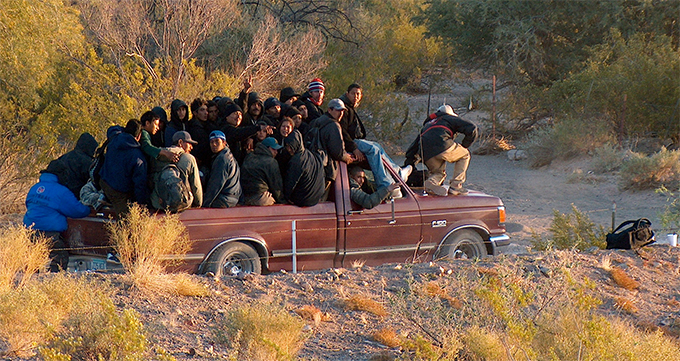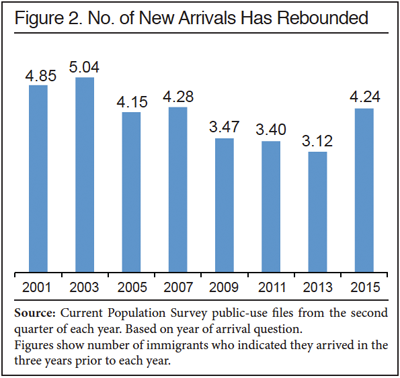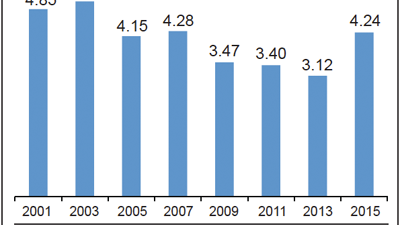Census: Record 42.1 million immigrants in U.S., Mexicans drive latest surge
Source: washingtonexaminer.com

A new analysis of legal and illegal immigrant counts by the Census Bureau revealed Thursday that there is a record 42.1 million in the United States, an explosion that is being driven by Mexicans flooding across the border.
In a report provided to Secrets by the Center for Immigration Studies, the total immigrant population surged 1.7 million since 2014. The growth was led in the last year by an additional 740,000 Mexican immigrants.
The 42.1 million tabulated by Census in the second quarter represent over 13 percent of the U.S. population, the biggest percentage in 105 years.
What's more, the numbers of immigrants coming and going from the U.S. is actually higher since many return home every year, said the report. "For the immigrant population to increase by one million means that significantly more than one million new immigrants must enter the country because some immigrants already here return to their homeland each year and natural mortality totals 250,000 annually," said the Center.
The stunning growth is sure to pour fuel on the already white-hot immigration debate in Congress and on the presidential campaign trail.
"Illegal immigration came up in the presidential debates, but there has been little discussion of the level of immigration; this at a time when total immigration is surging according to the latest data," said Steven Camarota, co-author of the report and the Center for Immigration's director of research.
"The rapid growth in the immigrant population was foreseeable given the cutbacks in enforcement, our expansive legal immigration system, and the improvement in the economy. But the question remains, is it in the nation's interest?" he added.

Some key findings in the new report:
- The nation's immigrant or foreign-born population, which includes legal and illegal immigrants, grew by 4.1 million from the second quarter of 2011 to the second quarter of 2015 — 1.7 million in just the last year.
- Growth in the last year was led by a rebound in the number of Mexican immigrants, which increased by 740,000 from 2014 to 2015 — accounting for 44 percent of the increase in the total immigrant population in the last year.
-The total Mexican immigrant population (legal and illegal) reached 12.1 million in the second quarter of 2015 — the highest quarterly total ever.
- The Department of Homeland Security and other researchers have estimated that eight in 10 illegal immigrants are from Mexico and Latin America, so the increase in immigrants from these countries is an indication that illegal immigration has begun growing again.
Much of the new immigration is due to the explosion of green cards and the flood of younger Latin Americans leaving troubled situations back home.
Many companies, meanwhile are taking advantage of the immigrants and replacing higher paid Americans with cheaper immigrant labor, even in skilled jobs.
Polls, meanwhile, show that the public wants action to stop the surge of illegal immigrants and new foreign workers, an issue picked up by some of the Republicans running for president such as Sen. Ted Cruz and Donald Trump.
Source: washingtonexaminer.com
Foodbanks Across the Country Struggle to Meet Demand
From: hosted.ap.org
Food banks across the country are seeing a rising demand for free groceries despite the growing economy, leading some charities to reduce the amount of food they offer each family.
U.S. food banks are expected to give away about 4 billion pounds of food this year, more than double the amount provided a decade ago, according to Feeding America, the nation's primary food bank network. The group gave away 3.8 billion in 2013.
While reliance on food banks exploded when the economy tanked in 2008, groups said demand continues to rise year after year, leaving them scrambling to find more food.
"We get lines of people every day, starting at 6:30 in the morning," said Sheila Moore, who oversees food distribution at The Storehouse, the largest pantry in Albuquerque, New Mexico, and one where food distribution has climbed 15 percent in the past year.
Across the country in Gloucester, Massachusetts, The Open Door food pantry has given away 7.6 percent more food this summer than last, said the organization's executive director, Julie LaFontaine.
"There's always a real hustle and bustle," she said. "People coming and going."
James Ziliak, who founded the Center for Poverty Research at the University of Kentucky, said the increased demand is surprising since the economy is growing and unemployment has dropped from 10 percent during the recession to 5.3 percent last month.
However, many people who have found jobs are working only part-time or for low wages, and others have stopped looking for work.
"People who have low-wage jobs, who aren't receiving regular raises, are finding those earnings stretched thin," Ziliak said.
The drop in food stamp rolls by nearly 2.5 million people from recession levels could be contributing to the food bank demand, he said, because people who no longer qualify for the government aid may still not earn enough to pay their bills.
According to the U.S. Labor Department, wages and salaries rose only 0.2 percent in the second quarter of the year.
Feeding America spokesman Ross Fraser said a recent study by his organization estimated that 46 million people sought food assistance at least once in 2014.
Feeding America, which coordinates large food donations for 199 food banks nationwide, has seen donations of food and money to the Chicago-based organization climb from $598 million in 2008 to $2.1 billion in 2014. The group coordinates donations from larger retailers, like Walmart, while local food banks also seek food from smaller businesses and buy groceries with donated money.
The recession helped boost public awareness of food banks, which helped increase donations but also may account for more people seeking assistance.
Lisa Hamler-Fugitt, executive director of the Ohio Association of Food Banks, who has been working in food charities since the 1980s, said that when earlier economic downturns ended, food demand declined, but not this time.
"People keep coming earlier and earlier, they're standing in line, hoping they're get there before the food runs out," Hamler-Fugitt said.
In Iowa, two years of 20 percent increases in demand forced the Des Moines Area Religious Council Food Pantry Network on Aug. 1 to reduce the food given out at its 12 pantries from a four-day supply to three.
The council's executive director, the Rev. Sarai Schnucker Rice, said Iowa's low unemployment rate, at 3.7 percent, hasn't made a difference.
"The economy is really not getting better for low-income people," Rice said.
That includes Peggy Bragg, 56, of Des Moines, who has been out of work for months. Bragg, who lives with her daughter, says the pantry bridges the gap for four or five days a month when no money is left for food.
"I know what people go through," she said. "You have to choose between food and bills."
In Fort Smith, Arkansas, the monthly food giveaways at a local park by the River Valley Regional Food Bank draw about 1,000 families.
"When people are willing to stand in 100 degree weather for hours, that tells you something," said Ken Kupchick, the food bank's marketing director.
Demand is growing even in areas with booming economies, such as Austin, Texas.
Hank Perrett, president and chief executive officer of the Capital Area Food Bank of Texas, said the influx of new residents has been part of the problem, pushing up housing prices. Low-skill jobs often pay $10 an hour or less.
"It's impossible to live that way in Austin, Texas," said Perrett, whose group has doubled the size of its operation to meet the surging demand.
Source: hosted.ap.org






















